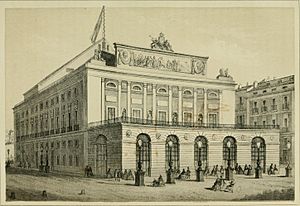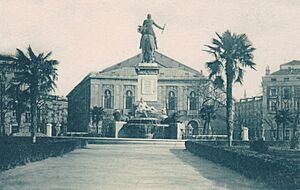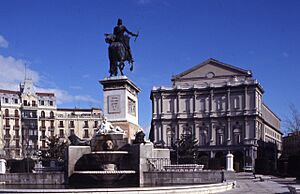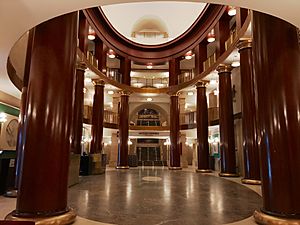Teatro Real facts for kids

Main façade towards Plaza de Oriente
|
|
| Location | Madrid, Spain |
|---|---|
| Coordinates | 40°25′06″N 3°42′37″W / 40.41833°N 3.71028°W |
| Public transit | Ópera |
| Operator | Fundación del Teatro Real |
| Type | Theatre |
| Genre(s) | Opera |
| Capacity | 1,958 seats |
| Construction | |
| Broke ground | 23 April 1818 |
| Built | 1818–1850 |
| Opened | 19 November 1850 |
| Reopened | 11 October 1997 |
| Rebuilt | 1991–1997 |
| Architect |
|
| Type: | Non-movable |
| Criteria: | Monument |
| Designated: | 30 June 1993 |
| Reference #: | RI-51-0008289 |
The Teatro Real (which means Royal Theatre or Royal Opera House in English) is a famous opera house in Madrid, Spain. It's right across from the Royal Palace in a place called Plaza de Oriente. People often call it "El Real" for short. It's known as one of the best places for music and performing arts in Spain and one of the most important opera houses in Europe.
Construction of the Teatro Real started on April 23, 1818, when King Ferdinand VII was in charge. It officially opened on November 19, 1850, by his daughter, Queen Isabella II. The theatre had to close in 1925 because of damage. It reopened on October 13, 1966, but as a place for orchestra concerts. From 1991 to 1997, it went through a big makeover. It finally reopened as an opera house again on October 11, 1997. The building is huge, with a floor area of 78,210 square meters and space for up to 1,958 people to sit.
Since 1995, a public group called Fundación del Teatro Real has managed the theatre. This group includes representatives from the Spanish government's Ministry of Culture, the Community of Madrid, and the City Council of Madrid. The main orchestra for the theatre since 1998 has been the Orquesta Sinfónica de Madrid.
Besides its regular shows of opera, dance, and concerts, the Teatro Real has hosted many special events. These include the 14th Eurovision Song Contest in 1969 and the 25th Goya Awards in 2011. Since 2012, it has also been the place for the special Christmas draw of the Lotería Nacional, which is Spain's national lottery. In 2021, the Royal Opera won the "Opera Company of the Year" award at the International Opera Awards. The building itself has been recognized as a special cultural landmark since 1993.
Contents
History of the Royal Theatre
How the Theatre Began
Before the Teatro Real, there was another theatre called Teatro de los Caños del Peral. It opened in 1738 during the time of King Philip V. This older theatre was built where an even older open-air theatre used to be. It got its name from a nearby fountain. The old theatre was taken down in 1817 to make room for the new Teatro Real.
Early Years and Famous Performances
King Ferdinand VII started the current theatre in 1818. It took 32 years to plan and build! A special order in 1850 said the "Teatro de Oriente" (as it was called then) needed to be finished right away. The building was done in just five months. Queen Isabella II officially opened the opera house on November 19, 1850. The first show was La favorite by Gaetano Donizetti.
Soon, the Madrid Opera became one of the most respected opera houses in Europe. For over 50 years, many famous singers and composers performed there. Early on, stars like Marietta Alboni and Giulia Grisi graced its stage. In 1863, the famous composer Giuseppe Verdi visited for the Spanish premiere of his opera La forza del destino. Later in the 1800s, artists like Adelina Patti and Julián Gayarre performed. In 1917, the Ballets Russes, a famous ballet company, performed there with Vaslav Nijinsky and Igor Stravinsky.
Life as a Concert Hall
In December 1925, the theatre had to close because the construction of the Madrid Metro (the city's subway) caused damage to the building. The government wanted to fix it and planned many renovation projects. However, the Spanish Civil War and money problems after the war stopped these big plans. Instead, a simpler restoration was done.
The theatre reopened on October 13, 1966. It became a concert hall and the main place for the Spanish National Orchestra and the RTVE Symphony Orchestra to perform. The reopening concert featured Beethoven's Symphony No. 9. The venue closed again for more renovations on October 13, 1988. From 1867 to 1925, and again from 1966 to 1990, the Royal Opera also housed the Madrid Royal Conservatory, a music school.
Modern Remodeling and Reopening
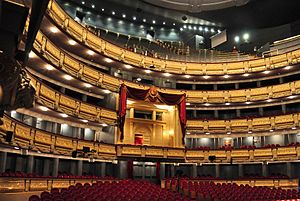
On January 2, 1991, the theatre began a major remodeling to become an opera house once more. The building work finished in late 1995. After that, it took a few more years to get everything ready. King Juan Carlos I and Queen Queen Sofía officially reopened the theatre on October 11, 1997. The first operas performed were El sombrero de tres picos and La vida breve by Manuel de Falla. Soon after, a new opera called Divinas Palabras by Antón García Abril had its first performance there, with the famous singer Plácido Domingo.
The renovation kept the old, classic style of an opera house. Some seats have a limited view of the stage. To help with this, live videos of the operas and ballets are shown on screens on the upper side walls. This way, everyone can follow the show. The theatre has a stage that is 1,430 square meters.
What's On Stage: Productions and Premieres
Each year, from September to July, the theatre puts on about 17 different operas and two or three big ballets. These can be their own shows or co-productions with other major opera houses around the world. They also host many concerts and recitals.
Some of the most popular operas at the Teatro Real have been Verdi's Rigoletto, which has been performed 409 times. Aida has been performed 378 times, and Il trovatore 356 times.
New Operas: World Premieres
Since it reopened, the Royal Opera has hosted the very first performances (world premieres) of many new operas. Besides Divinas Palabras, some others include:
- Don Quijote by Cristóbal Halffter (2000)
- La señorita Cristina by Luis de Pablo (2001)
- The Perfect American by Philip Glass (2013)
- ... by Charles Wuorinen (2014)
- El abrecartas by Luis de Pablo (2022)
- Extinción by Señor Serrano Group (2022)
The theatre also put on the first full stage production of Isaac Albéniz's Merlin in 2003. This was 101 years after it was finished!
Celebrating 200 Years
The Teatro Real celebrated its 200th anniversary with a special program from 2016 to 2018. One of the operas shown was Bellini's I puritani. A performance of this opera was even streamed live on the Royal Opera's Facebook page in July 2016. This helped the theatre reach a wider audience through digital services. The event was also shown in other venues and was a popular topic on Twitter in Spain.
Who Runs the Show: The Company
Since 1998, the main orchestra at the Teatro Real has been the Orquesta Sinfónica de Madrid. The current artistic manager is Joan Matabosch. The music director of the company since 2015 has been Ivor Bolton. He is scheduled to step down in 2025. In July 2022, the company announced that Gustavo Gimeno will be the next music director, starting in the 2025–26 season.
Artistic Directors (some examples)
|
Music Directors (some examples)
|
Special Events at the Theatre
The Teatro Real has been the setting for several important events throughout its history.
- On March 29, 1969, Televisión Española hosted the 14th Eurovision Song Contest there.
- On February 13, 2011, the Spanish film academy held the 25th Goya Awards ceremony at the theatre.
- Every year on December 22, since 2012, the Lotería Nacional's Christmas special draw takes place there.
Exploring the Building: Tours
The Opera House offers daily guided tours. These tours usually last between 50 and 90 minutes and are available in different languages. They give visitors a chance to see inside the building, including the stage area, the workshops where sets are made, and the rehearsal rooms. It's a great way to learn about how a big opera house works!
See also
 In Spanish: Teatro Real (Madrid) para niños
In Spanish: Teatro Real (Madrid) para niños
- Madrid Symphony Orchestra
- Spanish National Orchestra
- RTVE Symphony Orchestra
- National Auditorium of Music
- Zarzuela


